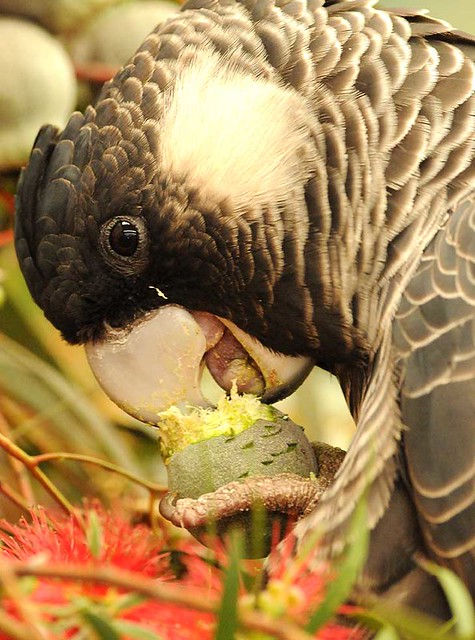Dramatic decline of endangered WA cockatoo
 Thursday, March 8, 2012 at 23:28
Thursday, March 8, 2012 at 23:28  Carnaby's Cockatoo - the already endangered bird has become even more so, with numbers plummeting nearly 40 per cent in the last year. Photo: Claire BartronThe population of one of the most endangered birds endemic to WA has significantly declined by 37 per cent in only one year, the latest count has revealed.
Carnaby's Cockatoo - the already endangered bird has become even more so, with numbers plummeting nearly 40 per cent in the last year. Photo: Claire BartronThe population of one of the most endangered birds endemic to WA has significantly declined by 37 per cent in only one year, the latest count has revealed.
Only 4222 Carnaby's black cockatoos were sighted across 185 locations from Geraldton to Esperance during the annual count, compared to 6672 sighted a year earlier.
BirdLife Australia, which conducts the annual count each April, found a 34 per cent decline in the Perth greater area up to April 2011.
The number of Carnaby's black cockatoos at each roost site also halved during the year, showing further evidence of the species' decline.
Unlike in previous years, there were no roosts with more than 500 cockatoos and the number of sites with between 151 and 500 cockatoos reduced by 42 per cent.
BirdLife Australia Black-Cockatoo conservation officer Tamara Kabat said the figures were concerning and a third count was needed to confirm the decline.
That will take place at sunset on April 15.
Endemic to WA, the large bird has a wingspan of up to 110 centimetres and weigh 520-790 grams, according to BirdLife Australia.
Its survival has been of increasing concern in recent years, with Perth's rapidly growing population and development invading the cockatoo's natural habitats.
Last year the state government approved a request by the University of Western Australia to build residential housing on one of the last remaining bushland homes of the Carnaby's black cockatoo.
It also supports the extension of the Roe Highway through the Beeliar Regional Park, south-east of Perth. Conservationists claim the road would significantly destroy the habitat of 122 bird species including the Carnaby's black cockatoo.
Opposition spokeswoman on the environment Sally Talbot said the decisions would have a devastating effect on the local population of the cockatoo.
"Now we have these disastrous figures from last year, Mr Marmion must take decisive action to save Western Australia's Carnaby's black cockatoos from extinction," she said.
"The minister could stop further destruction today. He must show some leadership on the issue and bring an immediate halt to the destruction of black cockatoo habitat until we work out how to save these birds from extinction."
Dr Talbot accused the minister of delaying the release of last year's count figures, which were presented to him six months ago.
"This is not the Great Cocky Count, this is the Great Cocky cover up that Bill Marmion's been engaged in," she said.
Ms Kabat said the final report had to be agreed to by both BirdLife Australia and the DEC.
Minister for Environment Bill Marmion said the government had spent $9.3 million protecting three species of cockatoo, Carnaby's, Baudin's and forest red-tailed since 2008-09.
The Department of Environment and Conservation also was preparing a new recovery plan for the Carnaby's cockatoo, while volunteer-driven black cockatoo projects had received a total of $175,000 in the first three funding rounds of the Environmental Community Grants Program.
"The Perth metropolitan region is growing and this growth continues to place pressure on black cockatoo habitat," Mr Marmion said.
"The state government recognises the importance of achieving the right balance between development and conservation. Through Federal and State Government offset policies we are securing habitat suitable for the species."
To volunteer at the April 15 count, contact Birdlife Australia at greatcockycount@birdlife.org.au.

